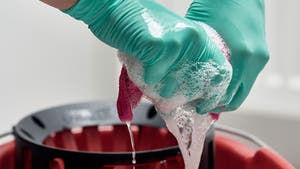This is the final post of a three-part blog series, COVID-19: Transition from Hospital to Home, by Doe Kley. Read part one and part two.
In part one of this 3-part blog series, we learned about SARS-CoV-2, the virus responsible for COVID-19 infection. We reviewed how infections occur using the Chain of Infection framework, including ways in which the chain can be broken to stop transmission. A special emphasis was placed on the role of environmental surfaces in transmission. In part two, we focused on preventing the transmission of COVID-19 within the hospital, looking at both what hospitals are doing and what patients can do. Next, we shared ways to prevent transmission to household contacts within the home environment. In this final part, we will review disinfectant safety and understanding the label.
Disinfectant Safety
The COVID-19 pandemic has brought to light the need for safe use of cleaners and disinfectants. Calls to Poison Control Centers regarding exposures to cleaners and disinfectants have increased since the beginning of 2020. In fact, the CDC published a Morbidity and Mortality Weekly Report (or MMWR) on this very topic in June of this year. They conducted a survey and found knowledge gaps in the safe use of household cleaners and disinfectants. Approximately one-third of the respondents reported engaging in non-recommended high-risk practices with the intent to prevent the spread of COVID-19 virus. Some of these unsafe practices include washing produce with bleach, applying these household cleaner-disinfectants to bare skin, and intentionally inhaling or ingesting these products.
It’s important to be knowledgeable about cleaning and disinfectant products being used. The product label provides a wealth of information so be sure to read it. A very important piece of information to look for is the registration number from the Environmental Protection Agency (EPA). All disinfectants in the US are required to be registered with the EPA. Failure of a disinfectant product to be registered with the EPA is not only against federal law, without it, the safety and efficacy of unregistered products cannot be guaranteed.
Other important information that can be found on the product label are the chemicals or active ingredients, the germs they kill (“kill claims”), precautions, and directions for use (DFUs). Keep in mind that SARS-CoV-2 is a new pathogen so it may not yet be listed on the label. However, if the product has the emerging viral pathogen claim and is listed on EPA’s List N, then the product is approved for use against the COVID-19 virus.
The precautionary text informs the user of potential hazards when using (or misusing the product). Signal words used in the precautionary text include CAUTION, WARNING, or DANGER and informs the user of physical or chemical hazards such as flammability and corrosiveness. This label section also advises on first aid instructions and if the product should be kept out of reach of children.
The DFUs focus on what task (e.g., disinfect, sanitize, deodorize, etc) the product is intended to perform and how to correctly use the product. This includes surfaces that the product can safely be used on as well as those the product should not be used on. The DFUs provide the contact time or how long the surface must remain wet with the disinfectant in order to be fully efficacious. It also addresses whether it’s safe or not to mix the product with other products or chemicals. For example, toxic fumes can result when bleach is mixed with ammonia or vinegar. Adherence to the DFUs is key. If product DFUs state to apply the product directly to the surface followed by wiping once the contact time has been met, then applying the product to the cloth first may impede efficacy.
Some key safety measures to consider include:
- Ensure the room being cleaned and disinfected has adequate ventilation
- Don’t mix bleach with other chemicals including vinegar and ammonia
- When diluting bleach, always add bleach to the water and not vice versa
- Don’t use cleaners and disinfectants on your bare skin
- Don’t ingest or inhale disinfectants
- Wear appropriate personal protective equipment such as gloves and eye protection according to manufacturer’s written instructions for use
- Wash hands after cleaning and disinfecting tasks or contact with any cleaners-disinfectants
- Store disinfecting products according to manufacturer’s instructions for use and keep them out of reach of children
Conclusion
In this 3-part blog series, we addressed the safe transition from hospital to home during a pandemic as it can be a very scary experience. And we learned that with basic infection control measures we can protect both ourselves and our loved ones. The COVID-19 pandemic has shown a glaring light on the need to faithfully adhere to these basic practices. Frequent hand hygiene, respiratory etiquette, and routine cleaning and disinfection go a long way in preventing transmission of pathogens, including SARS-CoV-2, the cause of COVID-19.
Be sure to educate yourself on proper cleaning and disinfection and understand what is in the bottle and how to safely use it. Always follow the instructions for use. Be sure you allow surfaces to remain wet long enough to kill the targeted pathogens. This means adhering to the contact time on the label for the product you are using.
To learn more, visit the CloroxPro Resource Center which includes valuable educational resources such as videos, pathogen education sheets, CE webinars and more.
For the latest information on COVID-19 and variants, visit our CloroxPro COVID-19 Hub.
References
1. Coronaviruses. Retrieved from https://www.niaid.nih.gov/diseases-conditions/coronaviruses
2. Coronavirus Disease 2019: Frequently Asked Questions. Retrieved from https://www.cdc.gov/coronavirus/2019-ncov/faq.html
3. Disease 2019: How it Spreads. Retrieved from https://www.cdc.gov/coronavirus/2019-ncov/prepare/transmission.html.
4. New coronavirus stable for hours on surfaces. Retrieved from https://www.nih.gov/news-events/news-releases/new-coronavirus-stable-hours-surfaces.
5. COVID-19, FAQ, Spread. Retrieved from https://www.cdc.gov/coronavirus/2019-ncov/faq.html#:~:text=At%20this%20time%2C%20CDC%20has,Coronavirus%20Spreads%20for%20more%20information.
6. Coronavirus Disease 2019: Symptoms. Retrieved from https://www.cdc.gov/coronavirus/2019-ncov/symptoms-testing/symptoms.html
7. Are You at Higher Risk for Severe Illness? Retrieved from https://www.cdc.gov/coronavirus/2019-ncov/specific-groups/high-risk-complications.html?CDC_AA_refVal=https%3A%2F%2Fwww.cdc.gov%2Fcoronavirus%2F2019-ncov%2Fhigh-risk%2Fhigh-risk-complications.html
8. Severe Outcomes Among Patients with COVID-19 – United States, February 12-March 16, 2020. Retrieved from https://www.cdc.gov/mmwr/volumes/69/wr/mm6912e2.htm
9. COVID-19 Cases in U.S. Retrieved from https://www.cdc.gov/coronavirus/2019-ncov/cases-updates/cases-in-us.html
10. CDC Media Telebriefing: Update on COVID-19, March 9, 2020. Retrieved from https://www.cdc.gov/media/index.htmlhttps://emergency.cdc.gov/coca/calls/2020/callinfo_013120.asp


